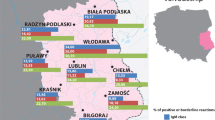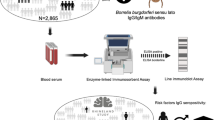Abstract
The ticks Ixodes persulcatus and Ixodes ricinus are the main vectors of both Borrelia burgdorferi sensu lato and tick-borne encephalitis (TBE) virus in Eurasia. Borrelia burgdorferi is the cause of Lyme borreliosis, and TBE is a biphasic meningoencephalitis induced by an arbovirus belonging to the flavivirus family. The principal aims of the current investigation were (i) to determine the frequency of serological evidence of Borrelia burgdorferi sensu lato and TBE infections in healthy agricultural and forestry workers, (ii) to determine the incidence of seroconversion for antibodies against Borrelia burgdorferi sensu lato and TBE virus in Tuscan workers during a 1-year survey; and (iii) to assess the occupational risk for agricultural and forestry activities in a defined area (Tuscany, Italy). A total of 412 blood samples were taken from agricultural and forestry workers, and information on age, duration of employment, and history of tick bites was collected in a questionnaire to establish the risk factors for the diseases. Three hundred sixty-five blood donors from the same region served as controls. To estimate the rate of seroconversion, 176 of the agricultural and forestry workers were tested 1 year later. IgG and IgM antibodies against Borrelia burgdorferi sensu lato and TBE virus were detected in serum by an enzyme-linked immunosorbent assay and confirmed by Western blot analysis for Borrelia burgdorferi and by a test for inhibition of hemagglutination for TBE. Antibodies against Borrelia burgdorferi were more frequent among the workers than in the control group (7.8% vs. 4.9% in the IgG-IgM enzyme-linked immunosorbent assay and 7.03% vs. 3.56% in the confirmatory test). No seropositivity was observed for TBE virus. Eighteen of 176 subjects who underwent a second blood test developed specific antibodies against Borrelia burgdorferi within 1 year.

Similar content being viewed by others
References
Zeman P, Januska J (1999) Epizootiologic background of dissimilar distribution of human cases of Lyme borreliosis and tick-borne encephalitis in a joint endemic area. Comp Immunol Microbiol Infect Dis 22:247–260
Parola P, Raoult D (2001) Ticks and tick-borne bacterial diseases in humans: an emerging infectious threat. Clin Infect Dis 32:897–928
Treib J et al (1996) Tick-borne encephalitis diagnosis in patients with inflammatory changes in the cerebrospinal fluid in a region with very low prevalence. Infection 24:400–402
Crovato F, Nazzari G, Fumarola D, Rovetta G, Cimmino MA, Bianchi G (1985) Lyme disease in Italy: first reported case. Ann Rheum Dis 44:570–571
Korenberg EI, Kovalevskii YV, Karanov AS, Moskvitina GG (1999) Mixed infection by tick-borne encephalitis virus and Borrelia in ticks. Med Vet Entomol 13:204–208
Verani P, Balducci M, Lopes MC, Alemanno A, Saccà G (1967) Survey for antibodies against arthropod-borne viruses in man and animals in Italy. I. Serologic status of human beings in a central Italian region (Fondi province). Am J Trop Med Hyg 16:203–210
Balducci M, Verani P, Lopes MC, Gregorig B (1967) Survey for antibodies against arthropod-borne viruses in man and animals in Italy. II. Serologic status of human beings in a northern Italian region (Gorizia province). Am J Trop Med Hyg 16:211–215
Cisak E et al (1998) Seroepidemiologic study on tick-borne encephalitis among forestry workers and farmers from the Lublin region (eastern Poland). Ann Agric Environ Med 5:177–181
Centers for Disease Control and Prevention (1995) Recommendations for test performance and interpretation from the Second National Conference on Serologic Diagnosis of Lyme Disease. MMWR Morb Mortal Wkly Rep 44:590–591
Clarke DH, Casals J (1958) Techniques for haemagglutination and haemagglutination-inhibition with arthropod-borne viruses. Am J Trop Med Hyg 7:561–573
Holzmann H, Kundi M, Stiasny K, Clement J, McKenna P, Kunz C, Heinz FX (1996) Correlation between ELISA, haemagglutination inhibition and neutralization tests after vaccination against tick-borne encephalitis. J Med Virol 48:102–107
Santino I, Sessa R, Di Pietro M, Del Piano M (2000) Lyme borreliosis in central Italy (1995–1998). New Microbiol 23:261–269
Ciceroni L, Ciarrocchi S (1998) Lyme disease in Italy, 1983–1996. Microbiologica 21:407–418
Weber K (2001) Aspects of Lyme borreliosis in Europe. Eur J Clin Microbiol Infect Dis 20:6–13
Ciceroni L, Ciarrocchi S, Ciervo A, Mondardini V, Guzzo F, Caruso G, Murgia R, Cinco M (2001) Isolation and characterization of Borrelia burgdorferi sensu lato strains in an area of Italy where Lyme borreliosis is endemic. J Clin Microbiol 39:2254–2260
Mannelli A, Boggiato G, Grego E, Cinco M, Murgia R, Stefanelli S, Meneghi D, Rosati S (2003) Acarological risk of exposure to agents of tick-borne zoonoses: first recognized Italian focus of Lyme borreliosis. Epidemiol Infect 131:1139–1147
Prokopowicz D, Bobrowska E, Bobrowski M, Grzeszcuk A (1995) Prevalence of antibodies against tick-borne encephalitis among residents of north-eastern Poland. Scand J Infect Dis 27:15–16
Verani P, Ciufolini MG, Nicoletti L, Lopes MC, Amaducci L, Fratiglioni L, Paci P, Leoncini F, Balducci M (1979) Circulation of TBE virus in Italy: seroepidemiological and ecovirological studies. In: Kunz C (ed) Proceedings and abstracts of International Symposium: Tick-Borne Encephalitis, Baden/Vienna, 19–20 October 1979, pp 265–272
Caruso G, Mondardini V, Granata C, Fornasier G, Benedetti P, Papa N, Maistri G, Ciufolini MG (1996) TBE virus-related disease in the Belluno area (north-east Italy): preliminary report of 15 cases. Giornale Italiano di Malattie Infettive 2:294–296
Ciufolini MG, Verani P, Nicoletti L, Fiorentini C, Bassetti D, Zarattini A, Caruso G (1999) Recent advances on the ecoepidemiology of tick-borne encephalitis in Italy. Alpe Adria Microbiol J 8:81–83
Rath PM, Ibershoff B, Mohnhaupt A, Albig J, Eljaschewitsch B, Jurgens D, Horbach I, Fehrenbach FJ (1996) Seroprevalence of Lyme borreliosis in forestry workers from Brandenburg, Germany. Eur J Clin Microbiol Infect Dis 15:372–377
Ciceroni L, Bartoloni A, Leoncini F, Ciarrocchi S, Pinto A, Favia G, Bartalesi F, Scagnoli L, Iori A (2003) Risk of tick-borne bacterial diseases in humans in the Florence area, Tuscany. Ann NY Acad Sci 990:1–4
Centers for Disease Control and Prevention Division of Vector-Borne Infectious Diseases (DVBID): Lyme disease. http://www.cdc.gov/ncidod/dvbid/lyme/index.htm. Cited November 2003
Trevejo RT, Krause PJ, Sikand VK, Schriefer ME, Ryan R, Lepore T, Porter W, Dennis DT (1999) Evaluation of a two-test serodiagnostic method for early Lyme disease in clinical practice. J Infect Dis 179:931–938
Robertson J, Guy E, Andrews N, Wilske B, Anda P, Granstrom M, Hauser U, Moosmann Y, Sambri V, Schellekens J, Stanek G, Gray J (2000) A European multicenter study of immunoblotting in serodiagnosis of Lyme borreliosis. J Clin Microbiol 38:2097–2102
Wilske B, Busch U, Fingerle V, et al (1996) Immunological and molecular variability of OspA and OspC. Implications for Borrelia vaccine development. Infection 24:208–212
Ulvestad E, Kanestrøm A, Sønsteby LJ, Jureen R, Omland T, Edvarsen B, Lundervik J, Kristoffersen E, Van Dam AP (2001) Diagnostic and biological significance of anti-p41 IgM antibodies against Borrelia burgdorferi. Scand J Immunol 53:416–421
Robertson JN, Gray JS, Stewart P (2000) Tick bite and Lyme borreliosis risk at a recreational site in England. Eur J Epidemiol 16:647–652
Piacentino JD, Schwartz BS (2002) Occupational risk of Lyme disease: an epidemiological review. Occup Environ Med 59:75–84
Centers for Disease Control and Prevention (1999) Recommendations for the use of Lyme disease vaccine. Recommendations of the Advisory Committee on Immunization Practices (ACIP). MMWR, Morb Mortal, Wkly Rep 48 (No. RR-7):1–17
Korenberg EI (1994) Comparative ecology and epidemiology of Lyme disease and tick-borne encephalitis in the former Soviet Union. Parasitol Today 4:157–160
Alekseev A (1995) Borrelia-virus-tick interface. In: Coons L, Rotschield M (eds) Proceedings and abstracts of the Second International Conference on Tick-Borne Pathogens at the Host-Vector Interface: a Global Perspective, Kruger National Park, South Africa. Vol.1, pp 244–256
Acknowledgements
This study was kindly supported in part by a grant from the Italian Ministry of Welfare. We thank all the forestry workers and blood donors who participated. We thank Dr. P. Scatolini, Dr. S. Fani, Dr. V. Peccetti, Dr. C. Fiumalbi, Dr. P. Capone Braga, and Dr. A. Cerrano of the respective local health agencies in the districts involved for providing blood samples and questionnaires of control and exposed groups.
Author information
Authors and Affiliations
Corresponding author
Rights and permissions
About this article
Cite this article
Tomao, P., Ciceroni, L., D’Ovidio, M.C. et al. Prevalence and incidence of antibodies to Borrelia burgdorferi and to tick-borne encephalitis virus in agricultural and forestry workers from Tuscany, Italy. Eur J Clin Microbiol Infect Dis 24, 457–463 (2005). https://doi.org/10.1007/s10096-005-1348-0
Published:
Issue Date:
DOI: https://doi.org/10.1007/s10096-005-1348-0




